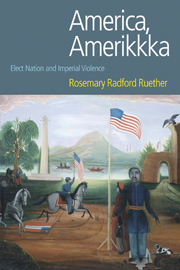Book contents
- Frontmatter
- Dedication
- Contents
- Introduction: THE TWO FACES OF AMERICA: THE IDEAL AMERICA AS DECEPTION AND AS PROTEST
- Chapter One ELECT NATIONS OF EUROPE AND THE MAKING OF THE AMERICAN MYTH OF CHOSENNESS
- Chapter Two THE RIGHTS OF MAN AND THE EXCLUDED OTHERS — THE REVOLUTIONARY ERA AND BEYOND
- Chapter Three MANIFEST DESTINY AND ANGLO-SAXON RACISM — 1815-1875
- Chapter Four MANIFEST DESTINY AND AMERICAN EMPIRE: 1890-1934
- Chapter Five AMERICA'S GLOBAL MISSION: THE COLD WAR ERA, 1945-89
- Chapter Six AMERICAN EMPIRE AND ITS DENOUEMENT: 1990-2007
- Chapter Seven ALTERNATIVE VISIONS OF AMERICA: THE PROTEST TRADITION
- Chapter Eight TOWARD A U.S. THEOLOGY OF LIBERATION AND LETTING GO
- BIBLIOGRAPHY
- INDEX OF BIBLICAL REFERENCES
- GENERAL INDEX
Chapter Five - AMERICA'S GLOBAL MISSION: THE COLD WAR ERA, 1945-89
- Frontmatter
- Dedication
- Contents
- Introduction: THE TWO FACES OF AMERICA: THE IDEAL AMERICA AS DECEPTION AND AS PROTEST
- Chapter One ELECT NATIONS OF EUROPE AND THE MAKING OF THE AMERICAN MYTH OF CHOSENNESS
- Chapter Two THE RIGHTS OF MAN AND THE EXCLUDED OTHERS — THE REVOLUTIONARY ERA AND BEYOND
- Chapter Three MANIFEST DESTINY AND ANGLO-SAXON RACISM — 1815-1875
- Chapter Four MANIFEST DESTINY AND AMERICAN EMPIRE: 1890-1934
- Chapter Five AMERICA'S GLOBAL MISSION: THE COLD WAR ERA, 1945-89
- Chapter Six AMERICAN EMPIRE AND ITS DENOUEMENT: 1990-2007
- Chapter Seven ALTERNATIVE VISIONS OF AMERICA: THE PROTEST TRADITION
- Chapter Eight TOWARD A U.S. THEOLOGY OF LIBERATION AND LETTING GO
- BIBLIOGRAPHY
- INDEX OF BIBLICAL REFERENCES
- GENERAL INDEX
Summary
For more than forty years two rival empires, identified with two rival ideologies, confronted one another across bristling shields of deadly weapons capable of destroying the peoples of the earth many times over. Each defined themselves in messianic terms as saviors of the world's peoples against a deadly foe. The U.S. saw itself as the leader of the ‘free world,’ champion of freedom and democracy, against an evil system of totalitarian repression and slavery. The Soviets saw themselves as the leader of an ‘inevitable’ process of world transformation from capitalist exploitation of the workers to socialist equality, over against a United States that had taken up the banner of European imperialism at a time when that system was dying.
Stages in the Cold War
The period from 1945 to 1989 was not one of uniform hostility. It took several years after the end of the Second World War for the wartime alliance of the U.S. and Western Europe with the Soviet Union to be redefined as one of unrelenting antagonism. After the death of Stalin in 1953 until the late sixties there was some relaxing of tensions followed by renewed periods of hostility. The period from 1969-1979 was one of détente in which both sides pursued negotiations to resolve major issues of dispute, particularly the nuclear arms race. SALT I, (Strategic Arms Limitation Treaty) signed by President Nixon and Soviet leader Brezhnev in 1972, ended the race to develop defensive antiballistic missile systems (AMBs) and froze the number of nuclear missiles to 1,600 on the Soviet side and 1,054 on the U.S. side.
- Type
- Chapter
- Information
- America AmerikkkaElect Nation and Imperial Violence, pp. 136 - 172Publisher: Acumen PublishingPrint publication year: 2007



